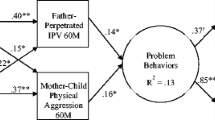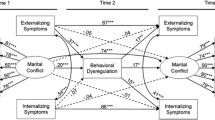Abstract
Previous research indicates that children from violent marriages are more likely to suffer from conduct problems and/or anxiety disorders than children from nonviolent, satisfactory marriages. However, knowledge regarding specific factors present in violent marriages relating to child problems is limited. The present study examined the relationships involving interspousal aggression, parent-child aggression, and child behavior problems in a sample of 45 children from maritally violent families. Mothers indicated how often their children witnessed interspousal aggression and were victims of parent-child aggression. Mothers also rated their children's problem behaviors while children reported on their own depressive symptoms. The witnessing of interspousal aggression was highly associated with parental aggression directed toward children. Parent-child aggression related to attention problems, anxiety-withdrawl, motor excess, and conduct problems in children. However, the witnessing of interspousal aggression was not significantly related to child behavior problems. These results are consistent with theoretical predictions linking marital problems to child behavior by virtue of their association with parenting.
Similar content being viewed by others
References
Bandura, A. (1973).Aggression: A social learning analysis. Englewood Cliffs, New Jersey: Prentice-Hall.
Bandrua, A. (1977).Social leaning theory. Englewood Cliffs, New Jersey: Prentice-Hall.
Belsky, J. (1984). The determinants of parenting: A process modelChild Development, 55, 83–96.
Emery, R. E., & O'Leary, K. D. (1984). Marital discord and child behavior problems in a nonclinic sample.Journal of Abnormal Child Psychology, 12, 411–420.
Friedrich, W. N., & Einbender, A. J. (1983). The abused child: A psychological review.Journal of Clinical Child Psychology, 12, 244–256.
Hershorn, M., & Rosenbaum, A. (1985). Children of marital violence: A closer look at the unintended victims.American Journal of Orthopsychiatry, 55, 260–266.
Hornung, C. A., McCullough, B. G., & Sugimoto, T. (1981). Status relationships in marriage: Risk factors in spouse abuse.Journal of Marriage and the Family, 43, 675–692.
Hughes, H. M., Barad, S. J. (1983). Psychological functioning of children in a battered women's shelter: A preliminary investigation.American Journal of Orthopsychiatry, 53, 525–531.
Johnson, P. L., & O'Leary, K. D. (in press). Parental behavior patterns and conduct disorders in girls.Journal of Abnormal Child Psychology.
Kovacs, M. (1981). Rating scales to assess depression in school-aged children.Acta Paedopsychiatrica, 46, 305–315.
Kovacs, M. (1983).The Children's Depression Inventory: A self-rated depression scale for schoolaged youngsters. Unpublished manuscript, University of Pittsburgh.
Lamphear, V. S. (1985). The impact of maltreatment on children's psychosocial adjustment: A review of the research.Child Abuse and Neglect, 9, 251–263.
O'Leary, K. D., Arias, I., Rosenbaum, A., & Barling, J. (1985).Premarital physical aggression. Unpublished manuscript, State University of New York at Stony Brook.
Patterson, G. R. (1982).Coercive family process. Eugene, Oregon: Castalia.
Porter, B., & O'Leary, K. D. (1980). Marital discord and childhood behavior problems.Journal of Abnormal Child Psychology, 8, 287–295.
Quay, H. C., & Peterson, D. R. (1983).Interim manual for the Revised Behavior Problem Checklist. Coral Gables, Florida: University of Miami.
Stewart, M. A., & duBlois, C. S. (1981). Wife abuse among families attending a child psychiatry clinic.Journal of the American Academy of Child Psychiatry, 20, 845–862.
Straus, M. A. (1979). Measuring intrafamily conflict and violence: The conflict tactics (CT) scales.Journal of Marriage and the Family, 41, 75–88.
Straus, M. A., Gelles, R. J., & Steinmetz, S. K. (1980).Behind closed doors: Violence in the American family. New York: Anchor Books.
Wolfe, D. A., Jaffe, P., Wilson, S. K., & Zak, L. (1985). Children of battered women: The relation of child behavior to family violence and maternal stress.Journal of Consulting and Clinical Psychology, 53, 657–665.
Author information
Authors and Affiliations
Additional information
This research was supported in part by a Grant-in-Aid of Research awarded to the first author by Sigma Xi, the Scientific Research Society, and NIMH Grant No. MH35340 awarded to the third author. The authors wish to thank Martha Wray and her staff at VIBS for their help throughout this project.
Rights and permissions
About this article
Cite this article
Jouriles, E.N., Barling, J. & O'Leary, K.D. Predicting child behavior problems in maritally violent families. J Abnorm Child Psychol 15, 165–173 (1987). https://doi.org/10.1007/BF00916346
Revised:
Issue Date:
DOI: https://doi.org/10.1007/BF00916346




